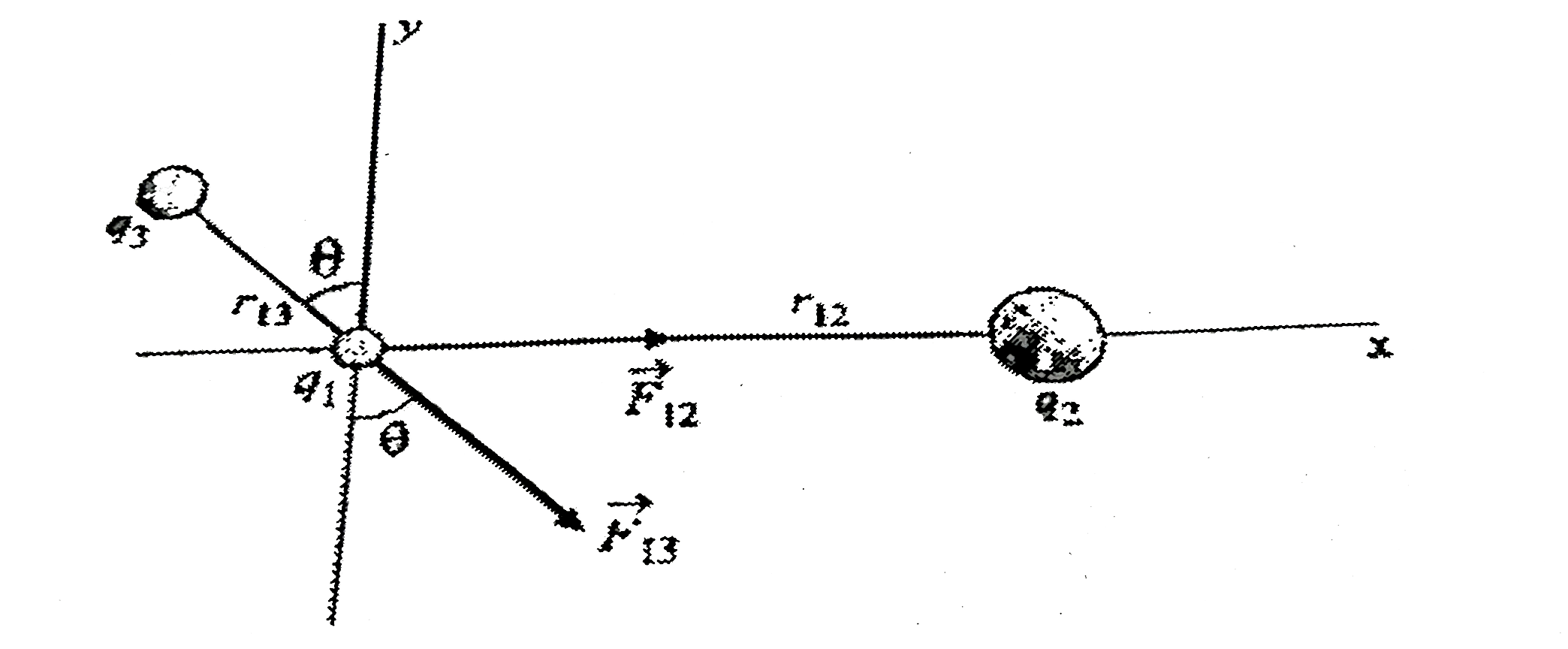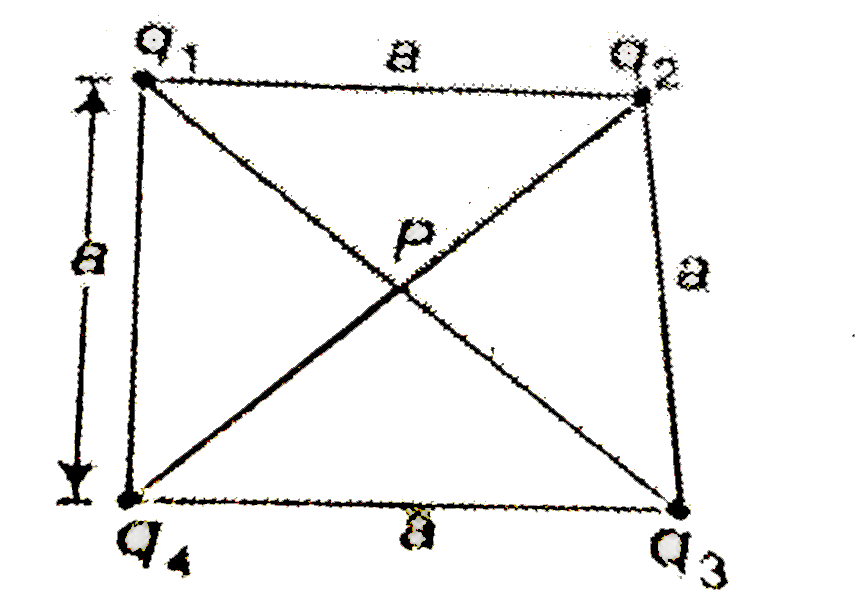Consider two point charges q1 and q2 at rest as shown in the figure. They are separated by a distance of 1 m. Calculate the force experienced by the two charges for the following cases:
(a) q1=+2μ C and q2=+3μC
(b) q1=+2μC and q2=−3μ C
(c) q1=+2μC and q2−3μ C kept in water (εr=80)


(a) q1=+2μ C and q2=+3μC and r=1 m. Both are positive charges . So the force will be repulsive
Force experienced by the charge q2 due to q1 is given by
→F=14πε0q1q2r2r12
Here r12 is the unit vector from q1 to q2 . Since q2 is located on the right of q1 we have ˆr12=ˆi , so that
→Fn=9×109×2×10−6×3×10−612ˆi[14πε0=9×109]
=54×10−3Nˆi
According to Newton .s third law the force experienced by the charge q1 due to q2 is →F12=−→F21
So that →F12=−54×10−3Nˆi
The directions of →F21 and →F12 are shown in the above figure in case (a)
(b) q1=+2μC,q2=−3μC and r=1 m. They are unlike charges . So the force will be attractive force experienced by the charge q2 due to q1 is given by
→F21=(9×109×(2×10−6)×−3×10−612ˆr12=−54×10−3Nˆi(Using ˆr12=ˆi)
The charge q2 will experience an attractive force towards q1 which is in the negative x direction .
According to Newton.s third law the force experienced by the charge q1 due to q2 is →F12=−→F21
So that →F12=54×10−3Nˆi)
The directions of →F21 and →F12 are shown in the figure (case (b)).
(c ) If these two charges are kept inside the water then the forrce experienced by q2 due to q1→Fw21=14πεq1q2r2ˆr12 Since ε=εrε0 ,
we have →Fw21=14πεrε0q1q2r2ˆr12=→F21εr
Therefore ˆFw21=−54×10−3N80ˆi=−0.675×10−3Nˆi
Topper's Solved these Questions
- BOOK - FULL MARKSCHAPTER - ELECTROSTATICS EXERCISE - Textual Evaluation Solved (Multiple choice questions : )15videos
ELECTROSTATICS
- BOOK - FULL MARKSCHAPTER - ELECTROSTATICS EXERCISE - Textual Evaluation Solved (II. Short Answer Questions : )21videos
ELECTROSTATICS
- BOOK - FULL MARKSCHAPTER - DUAL NATURE OF RADIATION AND MATTEREXERCISE - ADDITIONAL QUESTIONS -( ADDITIONAL NUMERICAL PROBLEMS : )10videos
DUAL NATURE OF RADIATION AND MATTER
- BOOK - FULL MARKSCHAPTER - MAGNETISM AND MAGNETIC EFFECTS OF ELECTRIC CURRENT EXERCISE - ADDITIONAL QUESTIONS SOLVED - NUMERICAL PROBLEMS :4videos
MAGNETISM AND MAGNETIC EFFECTS OF ELECTRIC CURRENT
Similar Questions
Two charge Q1=18μC and Q2=−2μC are separated by a distance R, and Q1 is on the left of Q2. The distance of the point where the net electric field is zero is
View SolutionTwo point charges qA=3μCandqB=−3μC are located 20cm apart in vacuum. What is the electric field at the mid point of the line joining the two charges.
 View Solution
View Solution
Knowledge Check
- Question 1 - Select One
Two point charges q1=+2C and q2=−1C are separated by a distance d. The position on the line joining the two charges where a third charge q=+1C will be in equilibrium is at a distance
Ad√2 from q1 and q2Bd√2 from q1 away from q2Cd√2−1 from q2 between q1 and q2Dd√2−1 from q2 away from q1 - Question 2 - Select One
Two charge Q1=18μC and Q2=−2μC are separted by a distance R, and Q1 is on the left off Q2. The distance of the point where the net electric field is zero is
Abetween Q1 and Q2Bleft of Q1atR/2Cright of Q2 at RDright of Q2 at R/2 - Question 3 - Select One
Two point charges q1=4μC and q2=9μC are placed 20cm apart. The electric field due to them will be zero on the line joining them at distamce of
A8cm from q1B8cm from q2C8013cm from q1D8013cm from q2
Three charges q1,q2 and q3 are shown in figure . Determine the net force acting on charge q1 . The charges and separation are given as q1=−1.0×10−6C,q2=+3.0×10−6C, and q3=−2.0×10−6C,r12=15cm,r13=10cm and θ=30∘.
 View Solution
View SolutionFour point charges q1,q2,q3 and q4 are placed at the corners of the squares of side a,as shown in figure.Calculate the potential at the centre of the square.

(Given, q1=1×10−8C,q2=−2×10−8C,q3=3×10−8C,q4=2×10−8C and a=1m)View SolutionIn the circuit shown in the figure K_(1) is open.The charge on capacitor C in steady state is q_(1) .Now key is closed and at steady state charge on C is q_(2) . The ratio of charges q_(1)/q_(2) is qquad R_(1)=2Omega E
View SolutionSix charges , q1=+1 μC , q2=+3 μC , q3=+4 μC , q4=−2 μC , q5=−3 μC and q6=−3 μC are placed on a sphee of radius 10 cm. The potential at centre of sphere is
View SolutionAssertion: Two charges q1 and q2 are placed at separation r. Then magnitude of the force on each charge is F.
Reason: Now a third charge q3 is placed near q1 and q2. Then force on q1 and q2 remains F.View Solution
